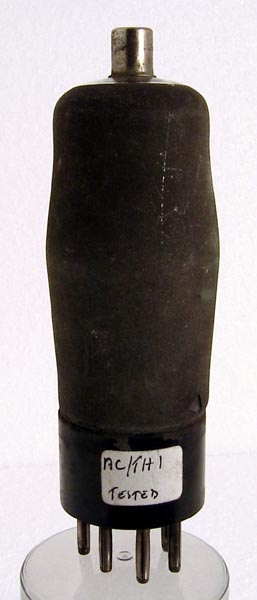|
AC/TH1Sensibly equivalent¶ to:See also:
|
|
|

|
The ACTH1 is a triode hexode frequency changer from Mazda. The triode is employed as the local oscillator and the hexode for the mixing process, the input signal being coupled to the control grid via the top cap for maximum separation of the circuits.This frequency-changer is a very well-designed valve capable of stable operation up to at least 30 MHz.Some sources of information state or at least imply that the AC/TH1 is in fact a triode-heptode rather than a triode-hexode. Since the additional grid would be connected internally to the cathode there is no way to resolve the issue except by taking a valve apart. It is entirely possible that the AC/TH1 was made in two versions at different times in its production life. This exhibit dates from the later 1930s.In addition to good isolation (so that the local oscillator frequency does not leak back to the aerial circuit) the design of the AC/TH1 made it remarkably resistant to 'pulling'. A characteristic of many unsophisticated frequency-changer stages is that the incoming signal, if large, will 'pull' the oscillator frequency slightly off the frequency set by the tuning knob and towards a frequency favourable to the (large) incoming signal.This means that if the radio is tuned slightly to one side of a strong station the local oscillator frequency automatically adjusts to pull in the strong station, ie. a simple form of AFC. This is fine if you just want to listen to local stations, but annoying if you want to listen to distant, weaker, stations on nearby wavelengths.The AC/TH1 thus meets an important need for overseas listeners, especially on short waves where oscillator pulling is particularly troublesome. Indeed, so effective was its resistance to pulling that you had to tune more carefully on strong stations to which a cheap radio would have just pulled on to even if the tuning was in accurate.The classic envelope is 38 mm in diameter and, excluding the B7 base pins, is 118 mm tall.References: Data-sheet & 1043. Type AC/TH1 was first introduced in 1936. See also 1936 adverts. |
Pin Connections
| 1 | 2 | 3 | 4 | 5 | 6 | 7 | tc |  a(t) | g1(t),g3 | g2,g4 | h | h | m,k | a | g1 |
|
|
Absolute Maximum Operating Conditions¶
| Vh | Ah | Va | Vs | Vg | mAa | mAs | ra | gm | 
| 4.0 | 1.3 | 250 | 100 | -3 | 3.0 | 6.0 | 1.6 | 0.75 |
|
Absolute Maximum Operating Conditions¶
| Va | mAa | 
| 80 | 4.5 |
|
Updated June 02, 2021.
|
|